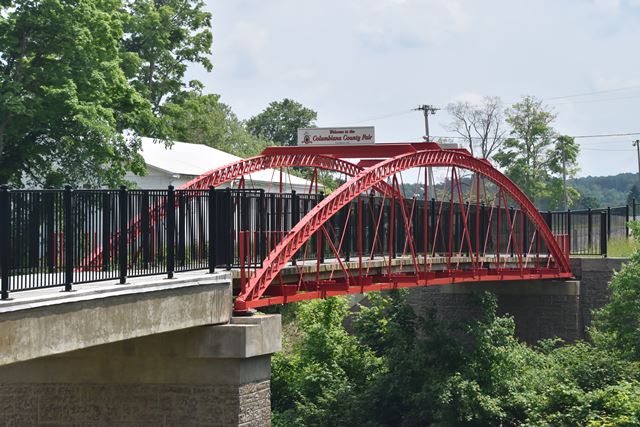We Recommend:
Bach Steel - Experts at historic truss bridge restoration.
BridgeHunter.com Phase 1 is released to the public! - Visit Now
Lisbon Bridge
Columbiana County Fairgrounds Bridge

Primary Photographer(s): Nathan Holth
Bridge Documented: May 29, 2018
Lisbon: Columbiana County, Ohio: United States
1872 By Builder/Contractor: Massillon Bridge Company of Massillon, Ohio
2017
102.7 Feet (31.3 Meters)
183.0 Feet (55.8 Meters)
10 Feet (3.05 Meters)
1 Main Span(s) and 1 Approach Span(s)
15XXXX2

View Information About HSR Ratings
Bridge Documentation
This bridge was built in 1872 over Middle Fork Little Beaver Creek, and replaced and put into storage in 1966. It was relocated and restored here in 2017. The overhead bracing is not original and was added to the bridge when it moved here, which is why HistoricBridges.org lists this as a pony truss bridge. This is a very long pony truss span for a bowstring truss, which is likely why the overhead bracing was added for safety when the bridge was restored. The crossing includes a modern pre-stressed concrete adjacent box beam span. The preservation of this bridge is a great success story and shows how even if a bridge has to be stored for decades sometimes it can still result in preservation eventually. The bridge is a beautiful part of the county fairgrounds.
Above: Photo of bridge in original location, courtesy Troy Graft, Columbiana County Chief Engineer.
Information and Findings From Ohio's Historic Bridge Inventory (Prior to Relocation)Setting/Context The bridge is in storage at the county garage. Integrity The bridge is in a storage lot, so it has lost some aspects of integrity. Summary of Significance The ca. 1870 bowstring truss bridge, although currently in storage, maintains the integrity of its truss lines and thus its technological significance as a rare bridge type/design. It is known as the Lisbon Bridge, but its original location is not documented by the available information in the ODOT environmental review files. The bridge is attributed to the Massillon Bridge Co. based on the construction of its arched top chords and comparison with other documented examples. Bowstring trusses are characterized by arched top chords and a trussed or lattice web. They rank among the rarest and most technologically significant of 19th-century metal truss designs since they appeared early in the evolution of iron bridge development and were almost always based on the patents or proprietary designs of bridge builders and engineers. The progenitor of the form was the famed engineer Squire Whipple of New York, who built the first example in 1840 over the Erie Canal at Utica. After the Civil War, Ohio was a center for the development of the bowstring with its concentration of metal bridge-building companies. Companies such Wrought Iron Bridge, Champion Bridge, Massillon Bridge, and King Iron Bridge built their reputations on successful bowstring designs with a dizzying number of variant ways of forming and connecting the truss members. The companies emerged in time to fill the burgeoning demand for an economical, prefabricated bridge for use on American roads. Bowstring trusses thus document this exceptionally inventive and technologically significant period in the development of American metal trusses from the 1860s to early 1880s. The ODOT inventory has identified 22 surviving examples dating from ca. 1864 to 1880 (Phase 1A, 2008). Justification The bridge is one of the 22 extant bowstring truss bridges that survive in the state. Having so many is remarkable, and even though they are "common" based on their numbers, each is an important and irreplaceable record of the development of the metal truss bridge and the ingenuity associated with the Ohio industrial development. The bridge has high significance. Bridge Considered Historic By Survey: Yes |
![]()
Photo Galleries and Videos: Lisbon Bridge
Bridge Photo-Documentation
Original / Full Size PhotosA collection of overview and detail photos. This gallery offers photos in the highest available resolution and file size in a touch-friendly popup viewer.
Alternatively, Browse Without Using Viewer
![]()
Bridge Photo-Documentation
Mobile Optimized PhotosA collection of overview and detail photos. This gallery features data-friendly, fast-loading photos in a touch-friendly popup viewer.
Alternatively, Browse Without Using Viewer
![]()
Maps and Links: Lisbon Bridge
Coordinates (Latitude, Longitude):
Search For Additional Bridge Listings:
Bridgehunter.com: View listed bridges within 0.5 miles (0.8 kilometers) of this bridge.
Bridgehunter.com: View listed bridges within 10 miles (16 kilometers) of this bridge.
Additional Maps:
Google Streetview (If Available)
GeoHack (Additional Links and Coordinates)
Apple Maps (Via DuckDuckGo Search)
Apple Maps (Apple devices only)
Android: Open Location In Your Map or GPS App
Flickr Gallery (Find Nearby Photos)
Wikimedia Commons (Find Nearby Photos)
Directions Via Sygic For Android
Directions Via Sygic For iOS and Android Dolphin Browser
USGS National Map (United States Only)
Historical USGS Topo Maps (United States Only)
Historic Aerials (United States Only)
CalTopo Maps (United States Only)


